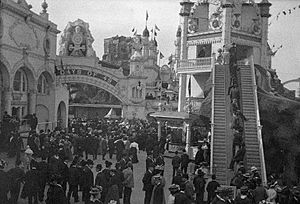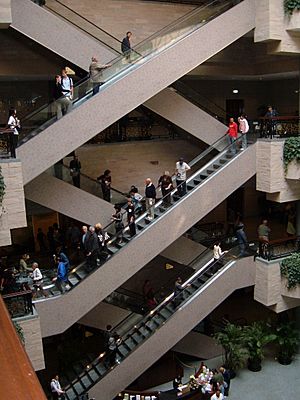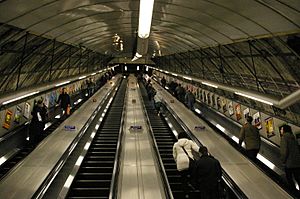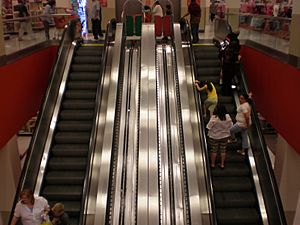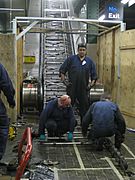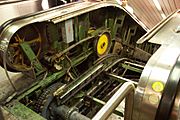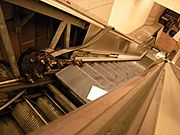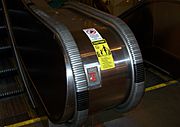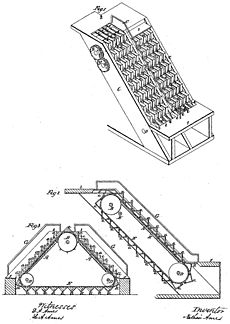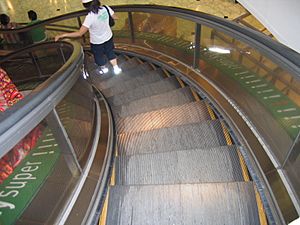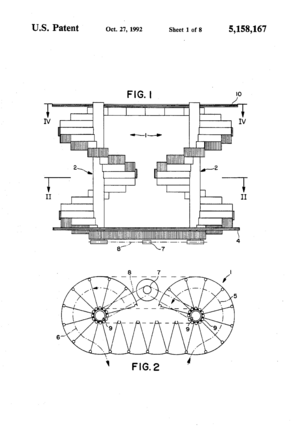Escalator facts for kids
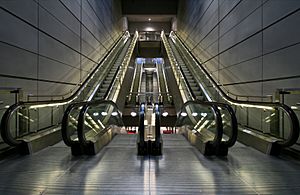
An escalator is a type of vertical transportation in the form of a moving staircase which carries people between floors of a building. It consists of a motor-driven chain of individually linked steps on a track which cycle on a pair of tracks which keep them horizontal.
Escalators are used around the world in places where elevators would be impractical. Principal areas of usage include department stores, shopping malls, airports, transit systems (railway/railroad stations), convention centers, hotels, arenas, stadiums and public buildings.
Escalators have the capacity to move large numbers of people. They can be placed in the same physical space as a staircase. They have no waiting interval (except during very heavy traffic). They can be used to guide people toward main exits or special exhibits. They may be weatherproofed for outdoor use. A nonfunctional escalator can function as a normal staircase, whereas many other methods of transport become useless when they break down or lose power.
Design, components, and operation
Operation and layout
Escalators are typically rise at an angle of about 30 degrees from the horizontal. ground. They move at 0.3–0.6 metres (1–2 ft) per second (like moving walkways) and may traverse vertical distances in excess of 18 metres (60 ft). Most modern escalators have single-piece aluminum or stainless steel steps that move on a system of tracks in a continuous loop.
Escalators are typically configured in one of three ways: parallel (up and down escalators adjacent or nearby, often seen in metro stations and multilevel movie theaters), multiple parallel (banks of more than one escalator going in the same direction parallel to banks going the other direction), or crisscross (escalators going in one direction "stacked" with escalators going the opposite direction oriented adjacent but perpendicular, frequently used in department stores or shopping centers).
Most countries require escalators to have moving handrails that keep pace with the movement of the steps as a safety measure. This helps riders steady themselves, especially when stepping onto the moving stairs. Occasionally, a handrail moves at a slightly different speed from the steps, causing it to "creep" slowly forward or backward relative to the steps. Slippage and normal wear can causes such losses of synchronicity.
The direction of escalator movement (up or down) can be permanently set, controlled manually depending on the predominant flow of the crowd, or controlled automatically. In some setups, the direction is controlled by whoever arrives first.
Design and layout considerations
Design factors include physical requirements, location, traffic patterns, safety considerations and aesthetics. Physical factors such as the distance to be spanned determine the length and pitch of the escalator, while factors such as the infrastructure's ability to provide support and power must be considered. How upward and downward traffic is separated and load/unload areas are other important considerations.
Temporal traffic patterns must be anticipated. Some escalators need only to move people from one floor to another, but others may have specific requirements, such as funneling visitors towards exits or exhibits. The visibility and accessibility of the escalator to traffic is relevant. Designers need to account for the projected traffic volumes. For example, a single-width escalator traveling at about 0.5 metres (1.5 ft) per second can move about 2000 people per hour, assuming that passengers ride single file. The carrying capacity of an escalator system is typically matched to the expected peak traffic demand. For example, escalators at transit stations must be designed to cater for the peak traffic flow discharged from a train, without excessive bunching at the escalator entrance.
In this regard, escalators help manage the flow of people. For example, at many airports an unpaired escalator delivers passengers to an exit, with no means for anyone entering at the exit to access the concourse.
Escalators are often built next to or around staircases that allow alternative travel between the same two floors. Elevators are necessary for disability access to floors serviced by escalators.
Components
Landing platforms
Landing platforms are the two platforms(at the two ends) that house the curved sections of the tracks, as well as the gears and motors that drive the stairs. The top platform usually contains the motor assembly and the main drive gear, while the bottom holds the step return idler sprockets. These sections also anchor the ends of the escalator truss. Each platform also has a floor and a comb plate. The floor plate provides a place for the passengers to stand before they step onto the moving stairs, flush with the rest of the floor and usually hinged to allow easy maintenance access, while the comb plate lies between the stationary floor plate and the moving step, so named for the cleats on its edge which mesh with the matching cleats on each step (and resemble a comb). The interlocking cleats help to minimize the gap between the stairs and landing, preventing objects or persons from becoming caught in it.
Truss
The truss is the hollow metal structure that bridges the lower and upper landings, composed of two side sections joined together with cross braces across the bottom and just below the top. The ends of the truss are attached to the top and bottom landing platforms via steel or concrete supports. It carries all the straight track sections connecting the upper and lower sections.
Balustrade
Either made of metal, sandwich panel, or glass, the balustrade supports the handrails of the escalator. It also provides additional protection for the handrail and passengers. Some escalators have direction arrows on the ends of the balustrade. Escalators' on/off buttons are frequently located at the ends of the balustrade. Moving walkways often use balustrades in the same way.
Tracks
The track system is built into the truss to guide the step chain, which continuously pulls the steps from the bottom platform and back to the top in an endless loop. One track guides the front wheels of the steps (called the step-wheel track) and another guides the back wheels of the steps (called the trailer-wheel track). The relative positions of these tracks cause the steps to form a staircase as they move out from under the comb plate. Along the straight section of the truss the tracks are at their maximum distance apart. This configuration forces the back of one step to be at a 90-degree angle relative to the step behind it. This right angle forces the steps into a shape resembling a staircase. At the top and bottom of the escalator, the two tracks converge so that the front and back wheels of the steps are almost in a straight line. This causes the stairs to lay in a flat sheetlike arrangement, one after another, so they can easily travel around the bend in the curved section of track. The tracks carry the steps down along the underside of the truss until they reach the bottom landing, where they pass through another curved section of track before exiting the bottom landing. At this point, the tracks separate and the steps once again assume a staircase configuration. This cycle is repeated continually as the steps are pulled from bottom to top and back to the bottom again.
Steps
The steps themselves are solid, one piece, die-cast aluminum or steel. Yellow demarcation lines are sometimes added to indicate their edges. In most escalator models manufactured after 1950, both the riser and the tread of each step is cleated (given a ribbed appearance) with comb-like protrusions that mesh with the comb plates on the top and bottom platforms and the succeeding steps in the chain. Seeberger escalators featured flat treads and smooth risers; other escalator models have cleated treads and smooth risers. The steps are linked by a continuous metal chain that forms a closed loop. The front and back edges of the steps each have two wheels, the rear of which are set further apart and fit into the trailer-wheel track while the front set have narrower axles and fit the step-wheel track.
Handrail
The handrail provides a handhold for passengers while they are riding the escalator. The handrail is pulled along its own track by a chain that is connected to the main drive gear by a series of pulleys, keeping it at the same speed as the steps. Four distinct sections make up the rail: at its center is a "slider", also known as a "glider ply," which is a layer of a cotton or synthetic textile that allows the rail to move smoothly along its track. The "tension member" lies on the slider and consists of either steel cable or flat steel tape, providing the handrail with tensile strength and flexibility. The inner components, on top of the tension member, are made of chemically treated rubber designed to prevent the layers from separating. Finally, the outer layer—the part that passengers see—is the cover, typically a blend of synthetic polymers and rubber. Covers are designed to resist degradation from environmental conditions, mechanical wear and tear and vandalism.
In a factory, handrails are constructed by feeding rubber through an extrusion machine to produce layers of the required size and type in order to match specific orders. The component layers of fabric, rubber and steel are shaped by workers before being fed into the presses which fuse them together.
In the mid-twentieth century, some handrail designs consisted of a rubber bellows, with rings of smooth metal cladding called "bracelets" between each coil. This gave the handrail a rigid yet flexible feel. Additionally, each bellows section was no more than a few feet long, so if part of the handrail was damaged, only the bad segment needed to be replaced. These forms of handrail have largely been replaced with fabric-and-rubber railings.
- Escalator components
Safety

Safety is a major concern in escalator design, as escalators are powerful machines that can become entangled with clothing and other items. Such entanglements can injure or kill riders. In India many women wear saris, increasing the likelihood of entangling the pallu. To prevent this, sari guards are built into most escalators in India.
Children wearing footwear such as Crocs and flip-flops are especially at risk of being caught in escalator mechanisms. The softness of the shoe's material combined with the smaller size of children's feet makes this sort of accident especially common.
Escalators sometimes include fire protection systems including automatic fire detection and suppression systems within the dust collection and engineer pit. To limit the danger caused by overheating, spaces that contain motors and gears typically include additional ventilation. Small, targeted clean agent automatic extinguishing systems are sometimes installed in these areas. Fire protection of an escalator floor opening is also sometimes provided by adding automatic sprinklers or fireproof shutters to the opening, or by installing the escalator in an enclosed fire-protected space.
History
Inventors and manufacturers
Nathan Ames
Nathan Ames, a patent attorney from Saugus, Massachusetts, is credited with patenting the first "escalator" in 1859, despite the fact that no working model of his design was ever built. His invention, the "revolving stairs", is largely speculative and the patent specifications indicate that he had no preference for materials or potential use (he noted that steps could be upholstered or made of wood, and suggested that the units might benefit the infirm within a household use). The suggested motive power was either manual or hydraulic.
Leamon Souder
In 1889, Leamon Souder successfully patented the "stairway", an analogous device that featured a "series of steps and links jointed to each other". No model was ever built. This was the first of at least four escalator-style patents issued to Souder, including two for spiral designs.
Jesse Wilford Reno, George A. Wheeler, and Charles Seeberger
On March 15, 1892, Jesse W. Reno patented the "Endless Conveyor or Elevator." A few months after Reno's patent was approved, George A. Wheeler patented his ideas for a more recognizable moving staircase, though it was never built. Wheeler’s patents were bought by Charles Seeberger; some features of Wheeler’s designs were incorporated in Seeberger’s prototype that was built by the Otis Elevator Company in 1899.
Reno, a graduate of Lehigh University, produced the first working escalator (called the "inclined elevator") and installed it alongside the Old Iron Pier at Coney Island, New York City in 1896. This particular device was little more than an inclined belt with cast-iron slats or cleats on the surface for traction, and traveled along a 25 degree incline. A few months later, the same prototype was used for a month-long trial period on the Manhattan side of the Brooklyn Bridge. Reno eventually joined forces with Otis and retired once he had sold his patents. Some Reno-type escalators were still being used in the Boston subway until construction for the Big Dig precipitated their removal. The Smithsonian Institution considered re-assembling one of these historic units from 1914 in their collection of Americana, but "logistics and reassembly costs won out over nostalgia," and the project was discarded.
Around May 1895, Charles Seeberger began drawings on a form of escalator similar to those patented by Wheeler in 1892. This device consisted of flat, moving stairs, not unlike the escalators of today, except for one important detail: the step surface was smooth, with no comb effect to safely guide the rider's feet off at the ends. Instead, the passenger had to step off sideways. To facilitate this, at the top or bottom of the escalator the steps continued moving horizontally beyond the end of the handrail (like a miniature moving sidewalk) until they disappeared under a triangular "divider" which guided the passenger to either side. Seeberger teamed with Otis in 1899, and together they produced the first commercial escalator. It won first prize at the 1900 Paris Exposition Universelle. Also on display at the Exposition were Reno's inclined elevator, a similar model by James M. Dodge and the Link Belt Machinery Co., and two different devices by the French manufacturers Hallé and Piat.
Early European manufacturers: Hallé, Hocquardt and Piat
Piat installed its "stepless" escalator in Harrods Knightsbridge store on Wednesday, November 16, 1898, though the company relinquished its patent rights to the department store. Noted by Bill Lancaster in The Department Store: a Social History, "customers unnerved by the experience were revived by shopmen dispensing free smelling salts and cognac." The Harrods unit was a continuous leather belt made of "224 pieces . . . strongly linked together traveling in an upward direction," and was the first "moving staircase" in England.
Hocquardt received European patent rights for the Fahrtreppe in 1906. After the Exposition, Hallé continued to sell its escalator device in Europe but was eventually eclipsed in sales by other major manufacturers.
American manufacturers and nomenclature
In the first half of the twentieth century, several manufacturers developed their own escalator products, though they had to market their devices under different names, due to Otis’ hold on the trademark rights to the word "escalator." New York-based Peelle Company called their models the Motorstair, while Westinghouse called their model an Electric Stairway. The Toledo-based Haughton Elevator company referred to their product as simply Moving Stairs. The Otis trademark is no longer in effect.
Alternate designs
Spiral/helical
Jesse Reno also designed the first escalators installed in any underground subway system in the form of a helical escalator at Holloway Road tube station in London in 1906. The experimental device never saw public use and its remains are now in the London Transport Museum's depot in Acton.
Although the first fully operational spiral escalator, Reno’s design was nonetheless only one in a series of similar proposed contraptions. Souder patented two helical designs, while Wheeler drafted helical stairway plans in 1905. Seeberger devised at least two helical designs between 1906 and 1911 (including an unrealized arrangement for the London Underground), and Gilbert Luna obtained West German, Japanese, and United States patents for his version of a spiral escalator by 1973. When interviewed for the Los Angeles Times that year, Luna was in the process of soliciting major firms for acquisition of his patents and company, but statistics are unclear on the outcome of these endeavors. Karl-Heinz Pahl received a European and a US patent for a spiral escalator in 1992.
The Mitsubishi Electric Corporation was most successful in its development of spiral/helical escalators, and it alone has sold them since the mid-1980s. The world's first practical spiral escalator—a Mitsubishi model—was installed in Osaka, Japan, in 1985.
Helixator, an experimental spiral/helical escalator design which currently exists as a prototype scale model, could further reduce floor space demands. Its design has several innovations that allow a continuous helix; driven by a linear motor instead of a chain system, it spreads force evenly along the escalator path, avoiding excessive force on the top chain links and hence avoiding the geometry, length and height limits of standard escalators.
Freeform
Levytator, a design originating at City University in London, can move in straight lines or curves with or without rising or descending. The returning steps do not move underneath the in-use steps: rather, they provide steps for travel in the opposite direction, as in the Pahl spiral escalator patent.
Extant historic escalator models
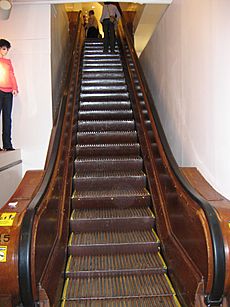
Notable examples of historic escalators still in operation include:
- Australia
- Town Hall railway station, Sydney, Australia. Opened 1932.
- Europe
- St Anna Pedestrian Tunnel underneath the Scheldt river in Antwerp, Belgium. Opened 1933.
- Maastunnel's bicycle/pedestrian tunnel, adjacent to its car tunnel in Rotterdam, The Netherlands. Opened 1942.
- Tyne Cyclist and Pedestrian Tunnel, Tyne and Wear, England. Made 1951.
- North America
- Macy's Herald Square department store upwards escalators, New York, USA. Opened 1920s.
Notable examples
Longest systems
- Central-Mid-Levels escalator, 2,600 feet (790 m): in Hong Kong, tens of thousands of commuters travel each work day between Central and the Mid-levels, a residential district hundreds of feet uphill, using this long distance system of escalators and moving walkways. It is the world's longest outdoor escalator system (not a single escalator span). It goes only one way at a time; the direction reverses depending on rush hour traffic direction.
- In December 2011, a network of six escalators of 1,260 feet (380 m) length, equivalent to 28 stories high, was opened in Medellín, Colombia, offering the 12,000 residents of Comuna 13 a six-minute ride to the city center compared to the previous 35-minute climb on foot.
- Cascade, Yerevan: an escalator system of 774 ft (236 m) length and 387 ft (118 m) height.
- Ocean Park, Hong Kong: a long escalator system connecting two parts of the Park, with an overall length of 730 feet (220 m).
Longest individual escalators
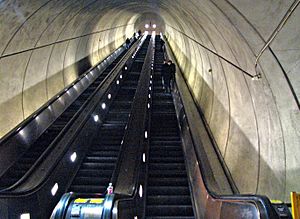
World
- The longest escalators in the world are installed in deep underground stations of the Saint Petersburg Metro. The Ploshchad Lenina, Chernyshevskaya, and Admiralteyskaya stations have escalators up to 138 m (453 ft) long and 69 m (226 ft) high.
- The longest freestanding (supported only at the ends) escalator in the world is inside CNN Center’s atrium in Atlanta. It rises 8 stories and is 205 feet (62 m) long. Originally built as the entrance to the amusement park The World of Sid and Marty Krofft, the escalator is now used for CNN studio tours.
Asia
- The Rustaveli station in the Tbilisi Metro has one of the world's longest escalators. It is 60 meters high and 120 meters long.
- One of the longest single escalators in Asia is in Chongqing, China. It joins the Chongqing Rail Transit underground station Lianglukou with the overground railway station at Caiyuanba. The escalator is 112 m (367 ft) long and has a transit time of about 2 minutes 30 seconds. The ride costs 2 yuan. Due to the hilly nature of Chongqing, the underground railway station is at the top of the escalator while the overground station is at the bottom.
- The longest escalator in Bangkok, Thailand and Southeast Asia is in the MRT's Si Lom Station. It connects the concourse level with platform 1 which in turn connects to Hua Lam Phong. It is 43 m (141 ft) in length and 21.5 m (71 ft) in depth.
Australia
- The longest set of single-span uninterrupted escalators in the Southern Hemisphere is at Parliament underground railway station in Melbourne.
Europe
- Three stations in Saint Petersburg Metro have escalators up to 138 m (453 ft) long and 69 m (226 ft) high: Ploshchad Lenina, Chernyshevskaya, and Admiralteyskaya.
- In the Park Pobedy station of the Moscow Metro, the escalators are 126.8 m (416 ft) or 740 steps long, and 63.4 m (208 ft) high. It takes three minutes to transit.
- The longest escalator in Prague, and in the European Union, is at the Náměstí Míru station at 285 feet (87 m) long and 142.5 feet (43.4 m) high.
- The longest escalators in Western Europe are in the Elbphilharmonie in Hamburg with a length of 82 m (269 ft), in Helsinki Airport Railway Station (74 m (243 ft)), and at Stockholm Metro station Västra skogen (67 m (220 ft)).
- The tallest escalator on the London Underground system is at Angel station with a length of 200 feet (61 m), and a vertical rise of 90 feet (27 m).
- The longest wooden escalators in the United Kingdom are at the Tyne Tunnel, with a length of 197 feet (60 m). (See above)
- The longest escalator of a European shopping mall is at MyZeil, Frankfurt, Germany, with a length of 150 feet (46 m).
- The largest "single truss escalator" is in the Bentall Centre in Kingston upon Thames in Greater London, UK. It connects the ground floor with the second floor with top and bottom supports.
North and South America
- The longest set of single-span uninterrupted escalators in the Western Hemisphere is at Wheaton station on the Washington Metro Red Line. They are 230 feet (70 m) long with a vertical rise of 115 feet (35 m), and take what is variously described as 2 minutes and 45 seconds or nearly three-and-a-half minutes, to ascend or descend without walking.
Shortest examples
According to Guinness, the shortest escalator in the world is the "Puchicalator" in the Okadaya Mores shopping mall in Kawasaki Japan. Its vertical rise is 32.8 inches (83 cm) and has 5 steps.
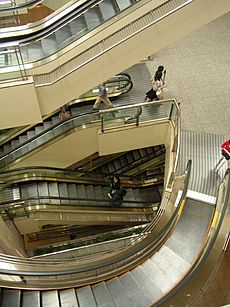
- Westfield San Francisco Centre, San Francisco, California, United States — the first spiral escalator in the Western Hemisphere.
- Westfield Garden State Plaza, Paramus, New Jersey, United States — one of the shortest escalators in North America. This escalator leads to the entrance of the JCPenney store.
Etiquette
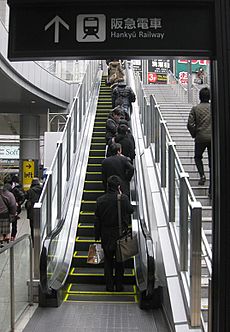
In most major countries, the expectation is that escalator users wishing to stand keep to one side to allow others to climb past them on the other. Germany, Hong Kong, Taiwan, the United Kingdom, and the United States have been cited as countries where riders are expected to stand on the right and walk on the left. However, in Australia and New Zealand, the opposite is the case. Practice may differ from city to city within countries – in Osaka, riders stand on the right, whereas in Tokyo (and most other Japanese cities), riders stand on the left.
In certain high-traffic systems, including the East Japan Railway Company and the Prague metro, escalator users are encouraged to stand on whichever side they choose, with the aim of preventing wear and tear and asymmetrical burdening. All Tokyo metro stations also have posters next to the escalators that ask users not to walk but instead to stand on either side.
The practice of standing on one side and walking on the other may cause uneven wear on escalator mechanisms.
Images for kids
-
Crisscross layout of escalators at Mahboonkrong Center, widely known as the MBK Center, in Bangkok. Such layouts are used to minimize structural space requirements by "stacking" escalators that go in one direction.
-
The longest escalators in the Western Hemisphere, at the Wheaton station, Washington DC Metro
-
Long escalators of Koivusaari metro station in Helsinki, Finland
See also
 In Spanish: Escalera mecánica para niños
In Spanish: Escalera mecánica para niños



